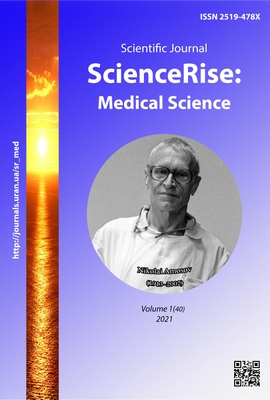Порушення респіраторної мікробіоти у дітей-інвалідів неврологічного профілю с повторними респіраторними захворюваннями
DOI:
https://doi.org/10.15587/2519-4798.2021.224333Ключові слова:
респіраторна мікробіота, повторні респіраторні захворювання, діти-інваліди, неврологічна патологіяАнотація
Актуальність проблеми рецидивуючих респіраторних захворювань у дітей з важкою неврологічною патологією зумовлена високою частотою, вираженістю клінічних симптомів та тривалим характером їх загострень, а також тенденцією до хронізації патологічного процесу.
Метою дослідження було вивчення респіраторної мікрофлори для оптимізації антибактеріальної терапії рецидивуючих респіраторних захворювань.
Методи та матеріали: Обстежено 16 дітей-інвалідів неврологічного профілю з повторними респіраторними захворюваннями. Проведено мікробіологічне дослідження верхніх дихальних шляхів за допомогою глибокого мазка з ротоглотки для виявлення можливого збудника захворювання.
Результати: У обстежених дітей виявлено виражений дисбаланс респіраторної мікробіоти, відповідний II і III ступеня дисбіотичних порушень. Особливістю мікрофлори верхніх дихальних шляхів було домінування Pseudomonas aeroginosa, кишково-опортуністичної мікрофлори (Klebsiella pneumoniae, Proteus vulgaris) та їх часте поєднання з Streptococcus pyogenus, Staphylococcus aureus, дріжджовими грибами роду Сandida. Максимальний ступінь порушень мікробіоти дихання відзначався у групі дітей із вродженими вадами розвитку мозку та корелював із тяжкістю бронхолегеневих захворювань. Аналіз чутливості патогенної мікрофлори до антибіотиків показав високу стійкість виявлених мікроорганізмів до більшості лікарських засобів.
Висновки: Респіраторна патологія у дітей-інвалідів неврологічного профілю характеризується рецидивуючим і хронічним бронхітом зі схильністю до затяжного перебігу, що визначає тривалість антибактеріальної терапії. Застосування неінвазивної методики вивчення респіраторної мікробіоти дозволяє виявляти передбачуваних збудників бронхо-легеневих захворювань і оптимізувати їх лікування
Посилання
Metelskaya, V. A., Alshkin, V. A., Voropaeva, E. A., Karaulov, A. V., Nesvizhsky, Yu. V., Afanasyev, S. S. et. al. (2010). Colonization resistance and immunological reactivity of children's oropharyngeal mucosa in health and bronchopulmonary pathology. Annals of the Russian academy of medical sciences, 7, 10–15.
Charlson, E. S., Bittinger, K., Chen, J., Diamond, J. M., Li, H., Collman, R. G., Bushman, F. D. (2012). Assessing Bacterial Populations in the Lung by Replicate Analysis of Samples from the Upper and Lower Respiratory Tracts. PLoS ONE, 7 (9), e42786. doi: http://doi.org/10.1371/journal.pone.0042786
Zakharova, I. N., Kasjanova, A. N., Klimov, L. Y., Kurianinova, V. A., Simakova, M. A. et. al. (2018). Respiratory tract microbiome: what is known today? Pediatrics (Suppl Consilium Medicum), 4, 10–17. doi: http://doi.org/10.26442/24138460.2018.4.180129
Ilchenko, S. I., Duka, E. D., Zhukova, L. A. (2016). Microaspiration Syndrome in Pediatric Practice: Modern Features and Role in Bronchial Obstruction Syndrome Formation. Child`s health, 7 (75), 90–94. doi: http://doi.org/10.22141/2224-0551.7.75.2016.86731
Metelskaia, V. A. (2013). Kharakteristika kolonizatsionnoi rezistentnosti slizistykh obolochek dykhatelnogo trakta pri bronkhitakh u detei. Moscow, 119.
Lupaltsova, O. S. (2014). Osobennosti mikroflory dykhatelnykh putei u detei s respiratornoi patologiei. Sovremennye aspekty infektsionnoi patologii. Astrakhan, 94–99.
Afanasev, S. S., Aleshkin, V. A., Voropaeva, E. A., Afanasev, M. S., Slobodeniuk, V. V., Karaulov, A. V. (2013). Microbiocenoses of open cavities and mucosal immunity. Effektivnaia farmakoterapiia, 1 (27), 6–11. Available at: https://umedp.ru/upload/iblock/87d/2.pdf
Samatova, E. V. (2012). Microbiocenosis Characteristics of the Low Respiratory Tract at Chronic Infectious-Inflammatory Pulmonary Diseases in Children and Antibiotic Resistance of Basic Pathogens. Journal of Ural Medical Academic Science, 1 (38). Available from: http://vestnikural.ru/article/osobennosti-mikrobiocenoza-nijnih-dyhatelnyh-putey-pri-hronicheskih-infekcionno-vospalitelnyh-zabolevaniyah-legkih-detey-i-antibiotikorezistentnost-osnovnyh-patogenov
Kamasheva, G. T., Belukhina, E. G., Sharipova, G. K., Karipollin, B. K. (2011). Kharakteristika mikrobiotsenoza verkhnikh dykhatelnykh putei u chasto boleiuschikh detei g. Semei. Nauka i zdravookhranenie, 1, 69–71.
Huffnagle, G. B., Dickson, R. P. (2015). The bacterial microbiota in inflammatory lung diseases. Clinical Immunology, 159 (2), 177–182. doi: http://doi.org/10.1016/j.clim.2015.05.022
Trinick, R. E., Bunni, L., Thorburn, K., Hackett, A. P., Dalzell, M., McNamara, P. S. (2015). An Observational Study Examining the Relationship between Respiratory Symptoms, Airway Inflammation and Bacteriology in Children with Severe Neurodisability. PLOS ONE, 10 (4), e0124627. doi: http://doi.org/10.1371/journal.pone.0124627
##submission.downloads##
Опубліковано
Як цитувати
Номер
Розділ
Ліцензія
Авторське право (c) 2021 Елена Сергеевна Коренюк

Ця робота ліцензується відповідно до Creative Commons Attribution 4.0 International License.
Наше видання використовує положення про авторські права Creative Commons CC BY для журналів відкритого доступу.
Автори, які публікуються у цьому журналі, погоджуються з наступними умовами:
1. Автори залишають за собою право на авторство своєї роботи та передають журналу право першої публікації цієї роботи на умовах ліцензії Creative Commons CC BY, котра дозволяє іншим особам вільно розповсюджувати опубліковану роботу з обов'язковим посиланням на авторів оригінальної роботи та першу публікацію роботи у цьому журналі.
2. Автори мають право укладати самостійні додаткові угоди щодо неексклюзивного розповсюдження роботи у тому вигляді, в якому вона була опублікована цим журналом (наприклад, розміщувати роботу в електронному сховищі установи або публікувати у складі монографії), за умови збереження посилання на першу публікацію роботи у цьому журналі.










